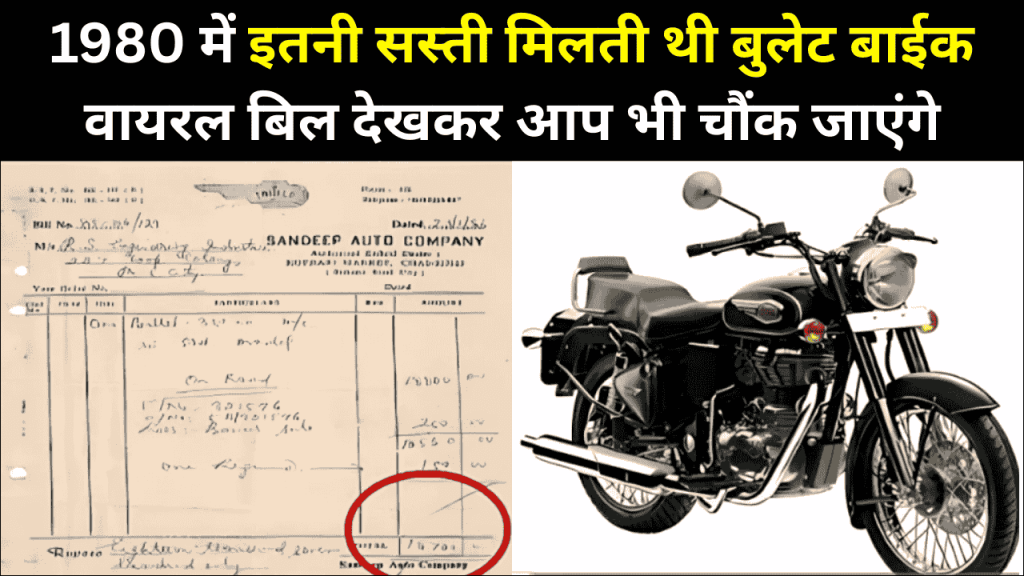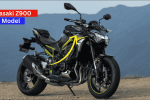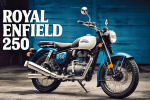
In today’s market where premium motorcycles often rival small cars in price, a recently viral image has captivated motorcycle enthusiasts across social media. The photograph—showcasing an original 1980s Royal Enfield purchase invoice—has triggered waves of nostalgia and astonishment throughout the motorcycling community. This historical document provides a fascinating window into how dramatically both the iconic brand and India’s motorcycle market have transformed over four decades.
The Invoice That Captured Public Imagination
The viral image reveals that a new Royal Enfield motorcycle in 1980 was available for a fraction of current prices. According to the widely-shared invoice, a Royal Enfield Bullet could be purchased for approximately Rs. 6,000 to Rs. 8,000, depending on variant. Even when adjusted for inflation, this represents a dramatically lower price point compared to today’s Royal Enfield lineup, which starts at Rs. 1.5 lakh and reaches Rs. 3.5 lakh for premium models.
What makes this discovery particularly remarkable isn’t merely the numerical price difference but what it represented in terms of accessibility. While a Royal Enfield purchase in 1980 still constituted a significant investment for average Indian families, it was considerably more attainable relative to contemporary income levels than today’s models.
Royal Enfield’s Evolution Through Time
Established in 1901 in Redditch, United Kingdom, Royal Enfield stands among the world’s oldest continuously produced motorcycle brands. The company’s Indian chapter commenced in 1955 when Enfield India began assembling motorcycles in Chennai (then Madras). By 1980, the brand had secured its reputation as a symbol of durability and power in the Indian marketplace.
The 1980s marked a critical period for Royal Enfield in India. While the original British company ceased operations in 1970, the Indian subsidiary continued manufacturing, focusing primarily on the Bullet model that had achieved legendary status for its distinctive exhaust note and robust construction.
During this era, Royal Enfield motorcycles gained popularity among government officials, military personnel, and police forces due to their reliability and commanding presence. The motorcycles represented more than transportation—they symbolized authority and distinction in Indian society.
From Practical Transport to Lifestyle Brand
The price comparison between 1980 and today reflects Royal Enfield’s remarkable transformation from utility vehicle manufacturer to aspirational lifestyle brand. In the 1980s, Royal Enfield motorcycles were valued primarily for their practicality, durability, and ease of maintenance under Indian conditions.
Today, while these qualities remain important, Royal Enfield has successfully repositioned itself as a premium heritage brand selling experiences rather than merely motorcycles. This strategic shift has enabled the company to command substantially higher prices while maintaining a devoted customer base.
The contemporary Royal Enfield owner often purchases more than transportation—they’re buying into a culture of leisure riding, adventure, and community. This fundamental change in brand positioning largely explains why consumers willingly pay significantly more for current models compared to their 1980s predecessors.
Technological Advancement and Quality Enhancements
It would be incomplete to discuss price differences without acknowledging that today’s Royal Enfield motorcycles are technologically superior to their 1980s counterparts. Modern models feature fuel injection, disc brakes, ABS, sophisticated suspension systems, and refined engines meeting current emission standards.
The 1980s models, while possessing a particular charm in their simplicity, lacked many features contemporary riders consider essential. They were characterized by heavy clutches, occasional oil leaks, and significant vibrations—qualities some enthusiasts appreciated but which would fall short of modern performance and comfort expectations.
This technological evolution has contributed substantially to price increases. Research, development, and implementation of modern technologies require significant investment, ultimately reflected in the motorcycle’s final cost.
The Appreciation of Vintage Models
Interestingly, well-maintained Royal Enfield motorcycles from 1980 have often appreciated considerably in value. Vintage models have become coveted collectors’ items, with exemplary preserved specimens sometimes commanding prices comparable to or exceeding new motorcycles.
This value appreciation underscores how effectively Royal Enfield has cultivated a heritage appeal transcending basic transportation utility. For many enthusiasts, owning a vintage Royal Enfield represents a connection to motorcycling history that contemporary machines cannot replicate.
Nostalgia as Marketing Strategy
The viral 1980 invoice does more than highlight price differences—it triggers complex emotional responses that marketers term “nostalgia marketing.” By evoking memories of seemingly simpler, more affordable times, such viral content creates emotional connections that can enhance the brand’s perceived value today.
Royal Enfield has skillfully leveraged this nostalgia factor in its contemporary marketing approach. While continuing to innovate and introduce new models, the company has carefully preserved the classic design elements and distinctive character that have defined the brand for generations.
Balancing Innovation with Heritage
As Royal Enfield expands globally and introduces new models like the Meteor, Himalayan, and 650 Twin series, it faces the ongoing challenge of balancing innovation with heritage. The viral 1980s invoice serves as a reminder of the brand’s evolution—not merely in pricing but in its entire business approach and market positioning.
For today’s motorcycle enthusiasts, the contrast between 1980s prices and current reality might initially provoke disbelief but ultimately offers an opportunity to appreciate the development of one of the world’s most enduring motorcycle manufacturers.
Looking Forward
The viral invoice has sparked conversations not just about pricing but about value, heritage, and the changing nature of motorcycle ownership. As Royal Enfield continues to evolve, this glimpse into its past provides context for understanding its present success and future direction.
While today’s Royal Enfield motorcycles may command prices many times higher than their 1980s ancestors, they represent a different value proposition—combining modern technology with carefully preserved heritage elements that continue to resonate with riders worldwide.
Key Questions Answered
How much did Royal Enfield motorcycles cost in 1980?
According to the viral invoice, Royal Enfield Bullets were priced between Rs. 6,000 and Rs. 8,000, depending on the variant.
How does this compare to current pricing?
Today’s models range from Rs. 1.5 lakh to Rs. 3.5 lakh—approximately 25-30 times higher than 1980 prices before accounting for inflation.
Were these motorcycles considered expensive in 1980?
Yes, they represented premium purchases even then, though they were relatively more affordable compared to today’s models when adjusted for average income levels.
What major improvements justify the price difference?
Modern Royal Enfields feature advanced technology including fuel injection, ABS, disc brakes, improved emission controls, enhanced suspension systems, greater reliability, and more refined engines.
Do vintage Royal Enfields hold value?
Well-maintained motorcycles from this era have become valuable collectibles, sometimes commanding prices comparable to new models among vintage motorcycle enthusiasts.




